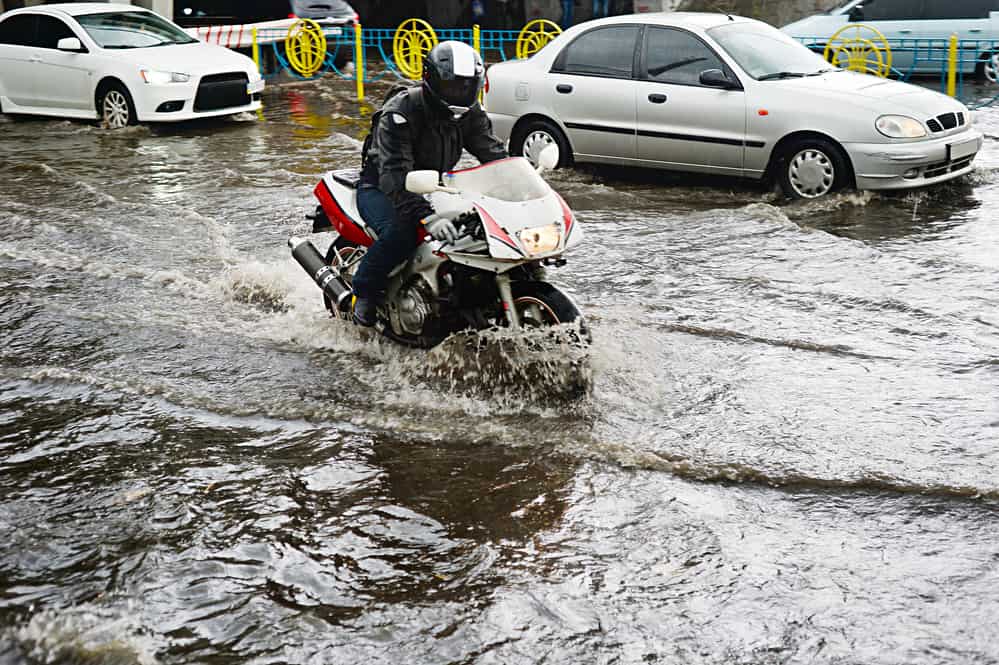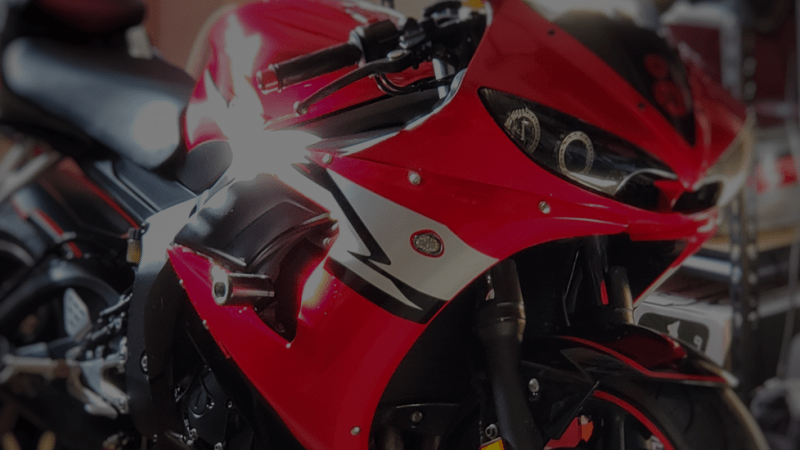Be it a shower or deluge, rain can be your worst nightmare when on a motorcycle if you’re not properly prepared. During the spring and winter months, precipitation is unpredictable, and if you are in a rainy state, expect to get caught at least one shower while riding your bike. Rather than avoiding rainy days altogether, learn to ride your motorcycle in the rain.
Before The Ride
For maximum safety, inspect your bike to make sure it’s ready to tackle a ride in the rain.
• Fluids: Check your motorcycle to make sure there’s no brake fluid or oil leakage. While oil leaks aren’t very dangerous in dry conditions, when oil mixes with water, the road becomes a slick and dangerous course.
• Brakes: Make sure the brake pads have enough material left to help you with prompt stops in wet conditions.
• Tires: Check that your tires have enough tread to push water away and grip the road. You also want to ensure they have enough air pressure. Under or over-inflated tires react differently in water, but both are potentially dangerous.
Weatherproof Gear
In order to keep you and your bike safe, you should have the correct riding gear and attire ready to go. You can choose between water-resistant and waterproof items. Water-resistant will shed water, but after a period of time, water will begin to permeate the material. Waterproof, on the other hand, will never allow for water to absorb into the material, unless you get completely submerged in water.
• Water-resistant or Waterproof Gear: Jackets and one piece suits should be zipped up tightly when riding in the rain to prevent water from seeping. Zippers should have a flap that covers the edges to protect the interstices. Cuffs on the jacket or coat need to be long enough to reach your gloves.
• Riding Boots and Gloves: More effective deterrents against complete saturation of your clothes. Both boots and gloves need to be tight enough to prevent water from dripping through. No one likes cold, wet socks.
• Helmets and Goggles: For the best protection, get a full-faced helmet. If you have a ½ or ¾ face helmet, get a pair of goggles. Pair the goggles with a waterproof balaclava that can shed water away from your face.
• Miscellaneous: If you have a saddlebag or storage unit, consider keeping a change of dry clothes with you. Also, keep plastic bags with you to keep valuables dry if you happen to get caught in a sudden rainstorm. Dry bags or waterproof backpacks can also help.

Be Cautious Of Road Conditions
Wet roads are dangerous for motorcyclists and other vehicle drivers, regardless of how prepared you may be. Even when the roads appear clean, they could be slick from oil. Here are some things to consider when traveling by motorcycle in the rain:
Less Traction
The first hour of rainfall is the most dangerous, because oils absorbed into the asphalt rise to the surface. During this time, it’s best to pullover at a rest stop about wait for about an hour. Once the rain has washed the road of oil and debris, you can head out again. Remember that this also means an increased braking distance.
Less Visibility
Sometimes, the fog or mist is too dense, or the rain is falling so hard you or other drivers can’t see. You can make yourself more visible to the traffic around you by wearing high visibility clothing and reflective patches.
Hydroplaning Risk
Hydroplaning occurs when water prevents the tire from making contact with the road. Reduce the risk of hydroplaning by avoiding painted lines, manhole covers, iridescent patches on the road and puddles (oil), tar snakes, metal crossing, and other places with reduced traction.
Also, you should reduce your speed when approaching puddles you can’t maneuver around. Start slowing down, squeeze the clutch, then coast through the puddle. If you’re going too fast, it’s better to maintain that velocity rather than slowing down abruptly, as this will reduce friction could cause fishtailing.
Decrease the risk of hydroplaning further with all-weather tires.
Nature’s Wrath
Stay aware of lightning, hail, ice, sleet, and other conditions that could transpire in a rainstorm. High winds can cause debris to fall into the road, and you might not see it due to decreased visibility. If it starts lightning, pull over.
Conclusion
Not every day is going to be perfect riding weather. Planning ahead and being prepared goes a long way when dealing with rainy conditions. Not only will you stay dry, but you will arrive at your destination safely.
Want more riding tips? Head over to my YouTube channel. Subscribe to receive notifications and never miss an update.
You Might also like
-
The Best Stretching Exercises for Sportbike Riders
Riding a sportbike can be an exhilarating experience, offering a sense of freedom and excitement. However, it can also be demanding on the body, particularly on the muscles and joints used most during rides. To ensure both safety and enjoyment while riding, incorporating stretching exercises into your routine is essential. Below, we outline the best stretching exercises specifically designed for sportbike riders, aiming to enhance flexibility, reduce muscle stiffness, and prevent injury.
Key Takeaways
- Stretching improves flexibility and range of motion, essential for comfortable and safe riding.
- Regular stretching can prevent muscle stiffness and soreness, particularly in areas heavily used during rides such as the wrists, shoulders, and legs.
- Incorporating exercise stretch bands can enhance stretching routines, offering resistance that can help improve overall flexibility.
Comparison Table: Stretching vs. No Stretching for Sportbike Riders
Criteria With Stretching Without Stretching Flexibility Improved Decreased Muscle Soreness Reduced Increased Injury Risk Lowered Elevated Riding Comfort Enhanced Compromised Recovery Time Shortened Lengthened Why Stretching is Crucial for Motorcycle Riders
Before delving into the specific exercises, it’s important to understand why stretching is so beneficial for motorcycle riders. Stretching can improve range of motion, decrease the risk of muscle soreness and injuries, and enhance your overall riding experience by keeping the body flexible and prepared for the demands of riding.
Best Stretches for Motorcycle Riding
- Wrist Extensor and Flexor Stretches
- Purpose: Alleviates wrist stiffness and prevents arm pump.
- How to Do: Extend your arm, palm down, and gently pull the fingers towards your body with the other hand. For the flexor stretch, extend your arm, palm up, and pull the fingers towards your body.
- Shoulder and Chest Openers
- Purpose: Opens the chest and shoulders, counteracting the forward-leaning posture.
- How to Do: Interlace your fingers behind your back, straighten your arms, and lift your chest upwards, feeling the stretch in your shoulders and chest.
- Hip Flexor Lunges
- Purpose: Loosens the hip flexors, crucial for maintaining a comfortable riding position.
- How to Do: Step forward into a lunge, keeping the back leg straight and the front leg at a 90-degree angle. Push your hips forward.
- Quadriceps Stretch
- Purpose: Stretches the front thigh muscles, which can become tight from the riding position.
- How to Do: Standing on one leg, pull the other foot towards your buttock, keeping the knees together.
- Seated Hamstring Stretch
- Purpose: Increases flexibility in the back of the legs.
- How to Do: Sit on the ground, extend your legs, and reach towards your toes.
- Glute and Piriformis Stretch
- Purpose: Relieves tightness in the buttocks and lower back.
- How to Do: Sitting on the floor, cross one leg over the other and gently pull the knee towards the opposite shoulder.
Incorporating Stretch Bands for Enhanced Flexibility
Exercise stretch bands can be a valuable tool for motorcycle riders looking to enhance their stretching routine. They provide resistance, increase the effectiveness of stretches, and help improve overall flexibility. Here are a couple of stretches using exercise bands:
- Band-Assisted Hamstring Stretch: Lie on your back, loop a band around your foot, and gently pull back, keeping the leg straight.
- Shoulder Stretch with Band: Hold a stretch band in both hands, lift your arms over your head and behind your back, stretching the shoulders.
FAQs on Stretching for Motorcycle Riding
- How often should I stretch?
- Ideally, before and after each ride to warm up and cool down the muscles.
- Can stretching improve my riding performance?
- Yes, by enhancing flexibility and reducing muscle fatigue.
- Are there stretches to prevent lower back pain from riding?
- Yes, hip flexor stretches and lower back stretches can help alleviate and prevent lower back pain.
- Why is stretching important for motorcycle riders? S
- tretching improves flexibility and reduces the risk of muscle stiffness and injuries, making riding more comfortable and enjoyable.
- How often should I stretch for the best results?
- Ideally, before and after each ride to prepare your muscles for the ride and to aid in recovery afterwards.
- Can stretching help with lower back pain from riding?
- Yes, specific stretches targeting the lower back and hip flexors can alleviate and prevent lower back pain.
- Are exercise stretch bands beneficial for riders?
- Yes, they add resistance to stretches, effectively improving flexibility and strength in key muscle groups.
- What are the best stretches for sportbike riders?
- Wrist, shoulder, hip flexor, quadriceps, hamstring, and glute stretches are highly beneficial.
- How long should each stretch be held?
- Each stretch should be held for at least 30 seconds to maximize its effectiveness.
Conclusion
Incorporating these stretching exercises into your routine can significantly enhance your motorcycle riding experience. Not only do they prepare your body for the ride, but they also help prevent post-ride stiffness and soreness. Remember, consistency is key to seeing improvements in flexibility and to enjoy a more comfortable and enjoyable ride.
For more tips on fitness and motorcycle riding, check out our Fitness Blog at RunTheCity. Whether you’re a seasoned rider or just starting, understanding and practicing these stretches can lead to a healthier, more enjoyable riding experience.
-
HJC IS-17 Motorcycle Helmet Review
The HJC IS-17 helmet is one of the most popular in HJC street helmets, made of advanced polycarbonate composite and with a new 3D face shield design. It is kind of a mixture of the HJC FG-17 and the HJC CL-17, although the FG-17 has a fiberglass composite shell and the IS-17 has a different fit than both the CL-17 and FG-17. Although the IS-17 has a comfortable fit and a sun visor that provides excellent coverage, it does not have good ventilation and the internal sun visor means it does not have Snell certification.
HJC IS-17 Motorcycle Helmet Overall Quality
All the parts of the IS-17 move together well despite the fact that the recommended retail price is around $162. Despite the cost, the paint and finish are good quality and comparable to helmets that are similarly priced, although it should not be compared to higher priced helmets like Arai or Shoei. The chin curtain, like the CL-17, is an option, although for a few extra dollars, it could be included as standard. The pinlock insert is also an option, although it is not as critical as the chin curtain. The clear plastic face shield has some waviness and clouding that could result in a visibility problem. In addition to the face shield, the fact that 85 percent of the vent holes are blocked is an issue. Very little air flows through the vents to the rider and the fabric liner across the top blocks the top vent.
Click Here For HJC Helmets 2017 Catalog
Helmet Fit, Internal Shape and Liner
The sizing seems slightly off in the IS-17 with an “XL” fitting more like an “L” and the internal shape feels mostly “neutral” rather than “slightly round” like other HJC helmets. This may be due to the sun visor at the forehead which gives a feeling of less room inside the helmet and a snug fit. The interior is nicely padded and the fabric comfortable. You can remove the cheek pads and liner for washing. There are also optional cheek pads in sizes that range from XS, at 40 mm thickness, to XXL, at 25 mm thickness.
HJC IS-17 Face Shield, Outward Visibility
The face shield operation in the IS-17 is exactly the same as the FG-17 with a center locking lift tab that works fine on the helmet. The center locking lift tab also allows you to adjust for city positions or for an initial defogging. It does have waviness that could affect visibility and which some riders may find unacceptable. The eye ports seem to be slightly better than average despite the sun visor. Once the shield is locked shut, it seals tightly around the eye port gasket. Water drains away from the rider along the top of the gasket and along the sides through a rotating mechanism. The face shield is easy to remove and can be replaced with optional mirrored or tinted face shields.
Helmet Ventilation and Air Flow
Ventilation and air flow in the helmet is one of the biggest problems. The top vent looks as if it should draw in a lot of air but the holes through the lining do not come close to lining up with the vents. In addition, the fabric liner blocks the vent holes to the point that even if air came into the helmet, you would not feel it because the holes are covered. This is not only true of the top vent, but also for the rear exhaust vents. The chin vent does direct air up, but it is an option with a price of between $4 and $5, something that is worth the added cost.
How are the Helmet Sound Levels?
The HJC IS-17 is quieter than most helmets with general wind noise around the sides. However, since the fit is tighter than other HJC helmets, it keeps the noise levels low. It works well as a windscreen and has low turbulence noise as well. Because the top vent holes are blocked, there is very little noise from the top of the helmet.
Although most of the features of the IS-17 make it a good option, the fact that it does not have the Snell M2010 rating is a major drawback. Studies have shown that nearly 23 percent of helmet impacts are in the forehead region where the internal sun visor sits. In addition, the top vent system and the wavy face plate present significant problems.
-
How To Start A Yamaha R6
Starting a motorcycle is easier than it used to be, thanks to technology. While there are various kinds of bikes, starting a Yamaha R6 or other fuel-injected motorcycles is more or less then same across the board.
Here is how you start a fuel-injected motorcycle, like the Yamaha R6:
How To Start A Yamaha R6 Starting The Engine of a Yamaha R6
You can find this information in the owner’s manual of your bike, too. Before starting the bike, make sure you have done the following:
- The transmission is in neutral.
- The transmission is in gear, the clutch is pulled, and the kickstand/sidestand is stowed. Some modern models, Yamaha included, have a safety feature that will prevent the bike from starting if the sidestand hasn’t been raised.
Next, follow these steps precisely:
- Insert the key into the ignition.
- Turn the key to the ON position. Make sure the engine stop switch is set to the correct position.
- Warning lights and indicator lights should illuminate momentarily then disappear if conditions are satisfactory. These lights include:
- Oil level
- Coolant temperature
- Fuel level
- Shift timing
- Engine problems
- Immobilizer system
- Shift the transmission into neutral. The light should come on. If not, you might have an electrical circuit problem.
- Start the engine with the start switch.
- In the event of failure, wait a few seconds and try another start. Don’t draw out the time trying to start the engine to preserve battery power. Do not extend for more than 10 seconds.
General Instructions for a Fuel-Injected Motorcycle
Here’s some instructions to follow if you don’t have the make/model mentioned above:
How To Start A Motorcycle
- Put the motorcycle in neutral. Neutral is always located between 1st and 2nd gear.
- Put the key in the ignition if necessary.
* Note: Fuel-injected motorcycles have an engine management system. This means you don’t have to worry about using the choke lever. Only a small amount of throttle will be needed, regardless of engine temperature. - Start pulling the clutch near the left handlebar. Some riders choose to pull the clutch and front brake simultaneously, but the choice is yours.
- Press and hold the start button. You will find this on the right handlebar. Maintain your hold on the clutch.
- The motorcycle should automatically catch and start.
- If the engine doesn’t turn over and start immediately, you can try using the throttle while pressing the start button. Make sure you are holding the clutch.
- Remember to never crank the engine for more than 10 seconds clips at a time. Otherwise, you’re wasting battery power.
- You can slowly start to release the clutch.
Now, you’re ready to ride!
Final Thoughts
Unlike carburetor motors, fuel injection systems rarely fail. To prevent the pump from failing, do some routine maintenance. Get into the habit of listening to the bike and know what a healthy running engine sounds like. That way, if something unusual happens, you will be able to tell whether or not something is wrong with the pump fuse by sound alone.
Modern fuel-injected motorcycles are easy to start. Follow the instructions in this article, and you will have no problem.
For more information about how to start, ride, and care for your motorcycle, check out my YouTube channel. Hit the subscribe button for notifications whenever there’s an update.




 HJC IS-17 Face Shield, Outward Visibility
HJC IS-17 Face Shield, Outward Visibility How are the Helmet Sound Levels?
How are the Helmet Sound Levels?






